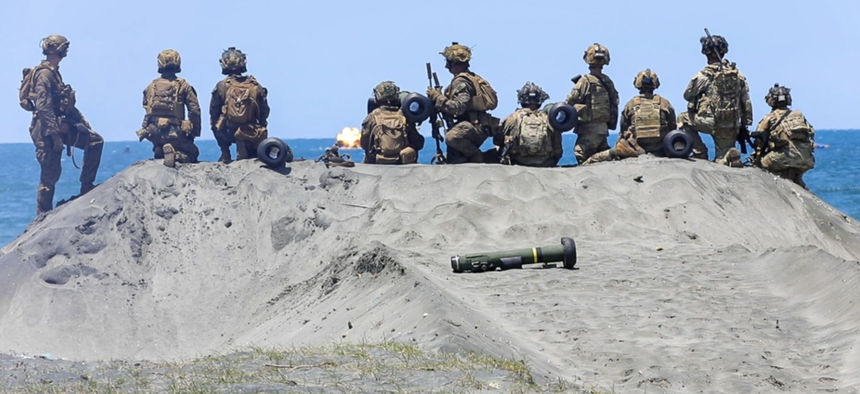
HONOLULU–When Army officials picked the 25th Infantry Division for the Transformation-in-Contact program, they knew water would shape its performance on the kind of island terrain that might be a future battlefield.
Firstly, because it’s much more humid in Hawaii year-round than Kentucky or New York, but also because the Indo-Pacific’s multi-island nations make it hard for infantry units to get around.
“So it depends on how much it’s been raining,” Sgt. Maj. Stephen Siglock, 25th ID’s operations sergeant major, told Defense One from the Philippines, where the division is participating in Exercises Balikatan and Salaknib from March through July. “Obviously, wet ground is harder to go, especially with slope… There’s some gnarly terrain out here.”
The infantry squad vehicle may be a big upgrade from the Humvee, which the Army recently announced it will axe, but soldiers are still trying to figure out how much equipment they can load onto it and still get it up a muddy hill in the jungle.
“More power is always better, but right now they have absolutely enough power,” Siglock said. ISVs “handle it better than any of our previous vehicles. Can they go over everything? Absolutely not, but no vehicle can. And then it’s once again, how do we carry our equipment as we’re going over that rough terrain?”
Then there’s the small drones, which have been a key feature of each TiC unit’s experimentation. High humidity and daily rain are a major consideration.
“Some of the optics sometimes might be degraded because of it, but that’s what we’re figuring out,” Siglock said. “I’ve seen our medium-range reconnaissance drones fly in fairly heavy rain and still be not as effective, but effective. Obviously, it will limit the range and somewhat degrade the optics.”
TiC allows the division to test some of the same systems that their fellow TiC units are testing, like the ISV and small drones, but also to put in some of their own requests, said Brig. Gen. Jonathan Velishka, 25th ID’s deputy commander for support.
“We’re getting it with their [after-action report] comments and some potential upgrades. We’re taking a turn on it, and we’re all feeding that ecosystem back into the Army for that, you know, continuous transformation of not just the organization and how we fight, but the equipment we’re using,” Velishka said.
For INDOPACOM, small drones are particularly useful for infantry units needed to get eyes across the water, because they can’t just send scouts on ground vehicles from island to island.
“Now we have equipment where we can fly a drone and recon the far, far side of a linear or open-water obstacle very, very, very quickly,” Siglock said. “So what would have taken us hours before now actually takes minutes, and it’s getting our soldiers to employ those devices often, just to save time and to basically make us more efficient, to where a smaller formation can cover a larger piece of ground.”
TiC also allows units to put in requests for specific wishlist items, Velishka said.
Power generation is one of those, he said, to help lighten the load of batteries and generators for units that are trying to be quiet and unencumbered by truckloads of equipment.
The division also has embedded support from developers working on a communications platform that can sync up unclassified, but still encrypted, data from the division down to smaller units.
“When we provide the feedback and say, ‘Hey, we’d like it if we could communicate this way with our partner, this way with our formations, the C2 Fix team, with their software engineers and our team, they immediately go after it, and we may see within days of the exercise that our situational awareness and our ability to communicate is enhanced from the brigade all the way down to the individual squad and soldier on the ground,” Velishka said.
While not every upgrade is instantaneous, Siglock said, the Army and industry developers are usually able to act on feedback between training events, as TiC units cycle from one partner exercise to a training center rotation and so on.
“Generally, I would say, after two or three reps, as we push the capabilities of these systems, we usually have good feedback for the vendors and for our leaders in the Army in general,” he said.
The post Muddy wheels, foggy lenses: 25th ID tests new vehicles, drones during Philippines exercises appeared first on Defense One.




